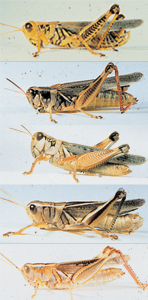 This past week, I was driving between Walnut Springs and Iredell. To my surprise the road was covered in grass hoppers. I have been on many farm and project visits all around the county the past couple of weeks. I knew we were going to have a higher than normal grasshopper population, but the sheer number I saw on that road was concerning.
This past week, I was driving between Walnut Springs and Iredell. To my surprise the road was covered in grass hoppers. I have been on many farm and project visits all around the county the past couple of weeks. I knew we were going to have a higher than normal grasshopper population, but the sheer number I saw on that road was concerning.
Grass hoppers have one life cycle per year. Bosque County has several species of grasshoppers that vary in size, color, and maturity which give the appearance of multiple cycles in a year, but that is incorrect. The population is usually kept in control by naturally occurring biological control agents such as bacillus thuringiensis (BT). This bacterium is found in the soil. During heavy rains the bacteria is splashed up on to plant leaves. It is then ingested by insects or in our case grasshoppers. The bacterium causes paralysis of the gut followed by death.
In a drought the bacteria must move deeper in the soil profile to find the moisture necessary for the bacteria to survive. Thus, it is not splashed on to a leaf for the subsequent ingestion by the insects. The bacteria may even cease to exist in some areas because of an extreme drought and need to be replenished from isolated pockets of deep subsoil moisture. The area between Walnut Springs and Iredell was a sandy soil, which would have the greatest likelihood of a low survival rate of BT.
Another natural enemy is the fungus, Entomophthora grylli, which often kills many grasshoppers when the weather is warm and humid. Infected grasshoppers strike a characteristic pose at the top of a plant or other object. The grasshopper grasps the plant in a death embrace with the front and middle legs, while the hind legs are extended. It dies in this position. Turkey, quail, cow birds, snakes and small mammals also feed on the grasshopper population. I hope this helps our turkey and quail populations.
The following is from our grasshopper control publication. Farmers and ranchers should start watching for grasshoppers early in the season and begin control measures while grasshoppers are still nymphs and still within the hatching sites (roadsides, fencerows, etc.). Treating grasshoppers early means…
1.) Having to treat fewer acres and use less insecticide;
2.) Killing grasshoppers before they cause extensive crop damage;
3.) Killing grasshoppers before they can fly, migrate, and lay eggs. Also, smaller grasshoppers are more susceptible to insecticides than larger ones.
You can estimate the size of a grasshopper infestation by surveying for nymphs or adults with the “square foot method.” Count the number of grasshoppers that hop or move within a square foot area. Then take 15 to 20 paces and sample another square foot area. Make 18 samples in all. Then add the numbers from each sample and divide the total by two to obtain the number of grasshoppers per square yard. If most grasshoppers you see are first to third instar (wingless and generally less than 1⁄2 inch long), divide the number by three to give the adult equivalent. Count fourth instar and older nymphs as adults.
Use Table 1 to determine different levels of threat posed by various population sizes.
| Table 1. Control thresholds based on numbers of adult grasshoppers per square yard. | ||
|
Rating |
Adults per square yard |
|
|
Margin |
Field |
|
| Non-economic |
5 to 10 |
0 to 2 |
| Light |
11 to 20 |
3 to 7 |
| Threatening |
21 to 40 |
8 to 14 |
| Severe |
41 to 80 |
15 to 28 |
| Very severe |
80 |
28+ |
| *Field ratings should be used for both rangelands and croplands | ||
By David Winkler
County Extension Agent – Ag
Texas A&M AgriLife Extension Service
Bosque County
